Marc Tyler Nobleman's Blog, page 26
January 23, 2019
Weekend in Marrakesh, Morocco
My kind new friends at the Casablanca American School helped me arrange a trip to Marrakesh, which some say is the most beautiful city in the country.
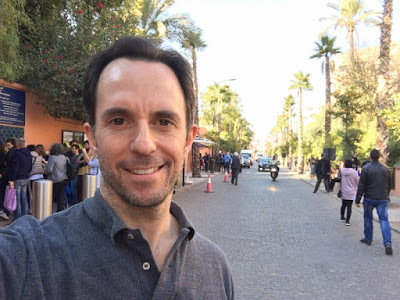
It's about two-and-a-half hours by train. I left Saturday morning and returned Sunday afternoon.
The train compartment in my section sat six, three and three facing each other; seats were assigned. On my way home, what I presume were a husband and wife were already seated when I got there. They were Muslim. The fourth to arrive was another Muslim women. I didn't understand what they said, but the husband and wife switched places so the two women would be sitting next to each other. (But they didn't speak to each other. I am sitting next to the man as I write this.)
The school warned me that Marrakesh taxi drivers try to take advantage of foreigners. They typically don't run the meter and charge whatever they want. I was therefore instructed to simply hand over 20 dirhams (about two dollars) for my six-minute ride and hop out. That wouldn't be so easy considering my bag would be in the trunk, so instead I was transparent up front.
At the train station in Marrakesh, I got in a taxi, gave the name of my hotel, and asked him to run the meter. He said no and explained that the tariff (by which I believe he meant fixed fee) was 100 dirhams (ten dollars). I said 20, he said no, I got out. I tried again—this time only 70 dirhams, but still much more than the actual rate. It took four tries to find a guy who begrudgingly agreed to 30 though I repeated that I would paying 20. (I ended up voluntarily paying 28.)
Shortly after settling in to the hotel, I set off on a three-hour tour of the city. My guide, Adil, kindly let me choose the destinations. Midway through, he told me that his first child was born only two days ago! I asked what he was doing with me and he said he has to work; besides, he said, a lot of family were at his house. At first I took this to mean that his wife had plenty of help; I later understood it also meant he needed a break from the crowd (only to lead a stranger through another).
The main sites I saw:
Majorelle GardensDjemaa el-Fnaa (main square)souks and beyondLazama Synagogue
Majorelle Gardens
Named for (and abounding with) Marjorelle Blue, a vibrant variation of the color that was created here.
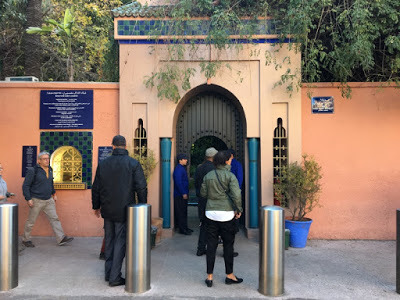
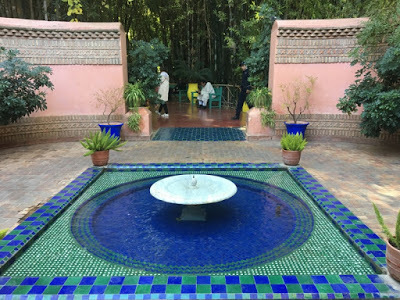
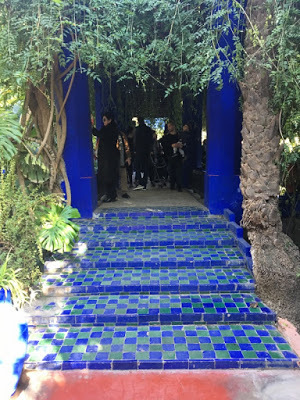
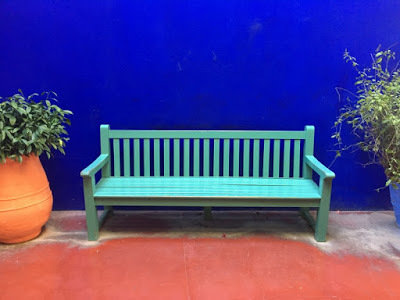
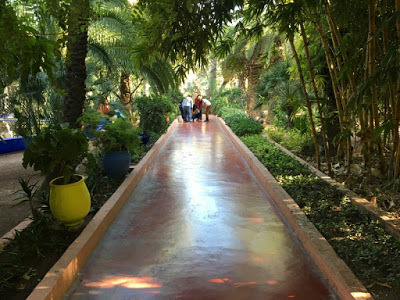
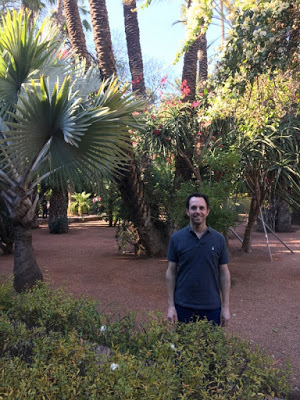
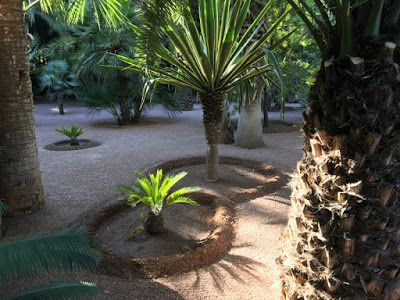
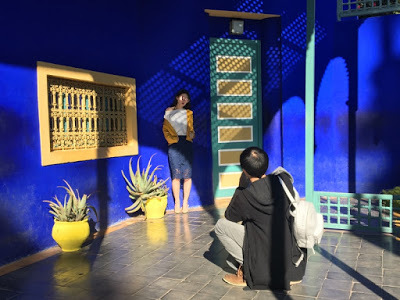 I saw it before Instagram did.
I saw it before Instagram did.
Djemaa el-Fnaa
The famous and expansive square home to food stalls and exotic entertainment for more than 1,000 years. Here there be cobras and monkeys (and, unfortunately, animal rights violations). One snake-charmer tried to force a snake around my neck so he could force (or at least guilt) me into handing over a few coins. I resisted…but not because I wasn't prepared to spend money.
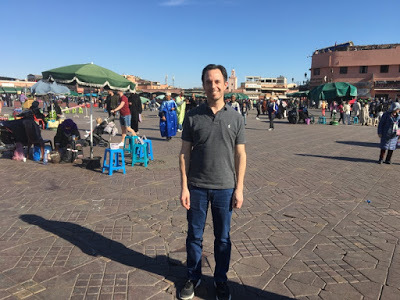
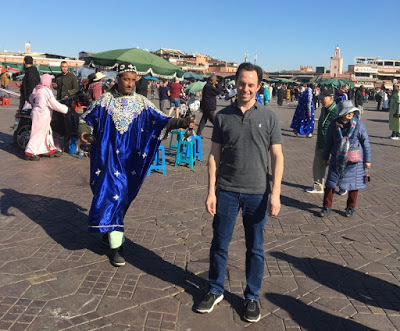
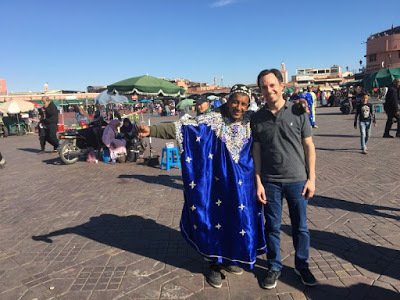 New best friend...for a price.
New best friend...for a price.
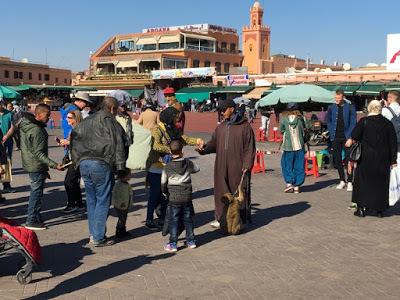 Note the sadly common sight of a monkey or Barbary ape,chained.
Note the sadly common sight of a monkey or Barbary ape,chained.
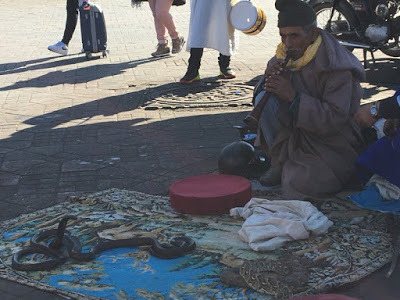
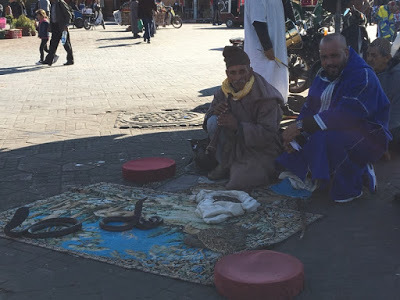
souks and beyond
These dried (and dyed) flowers are an invitation into this shop, housed in the former Jewish quarter.
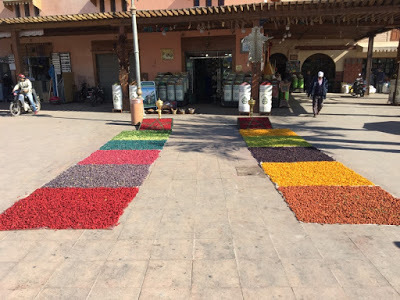
This is lipstick:
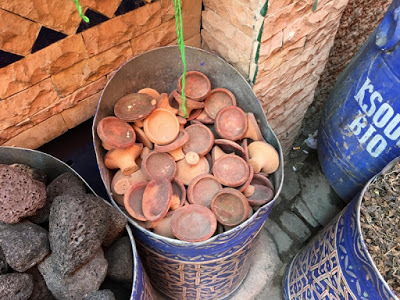
A defunct public fountain, used until the 1950s or '60s when people began to have running water at home:
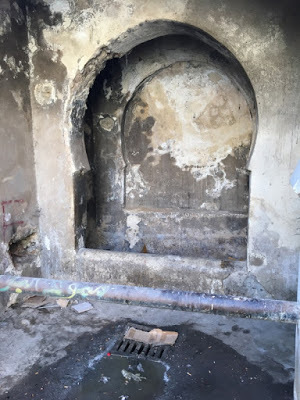
In Marrakesh, even the laundry is colorful:
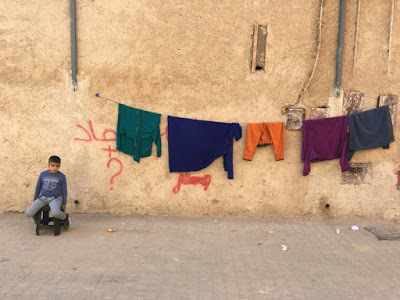
Lazama Synagogue
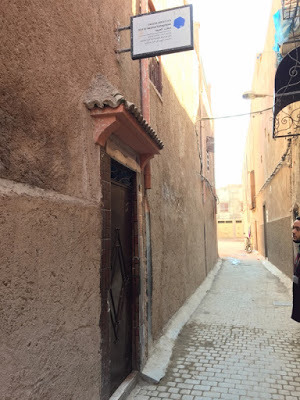
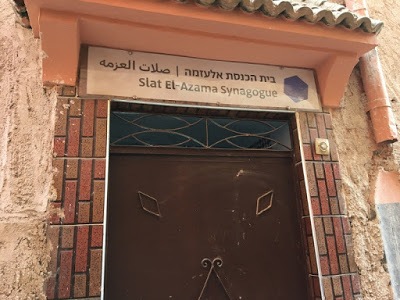
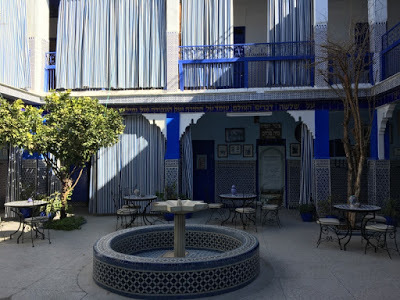
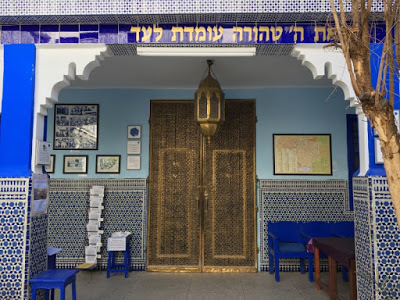
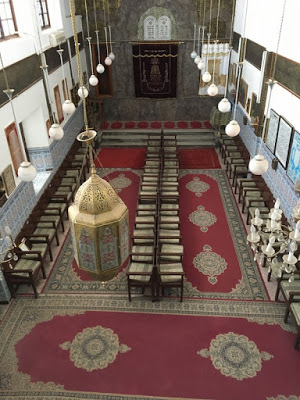
The area for female prayer is a fraction of the space as what the men get down below.
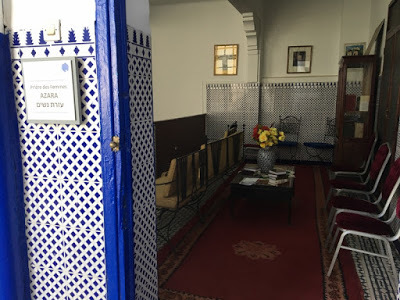
Though Jews left this part of the city in large numbers after World War II, the Jewish street names remain.
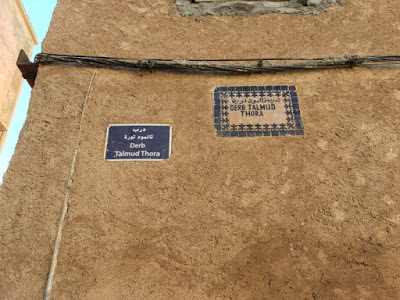
A view within my hotel, floor 3:
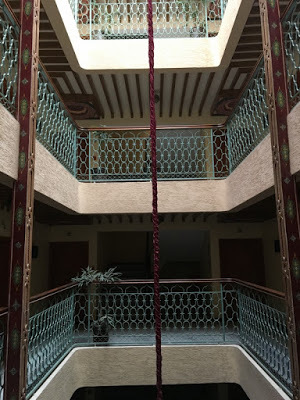

It's about two-and-a-half hours by train. I left Saturday morning and returned Sunday afternoon.
The train compartment in my section sat six, three and three facing each other; seats were assigned. On my way home, what I presume were a husband and wife were already seated when I got there. They were Muslim. The fourth to arrive was another Muslim women. I didn't understand what they said, but the husband and wife switched places so the two women would be sitting next to each other. (But they didn't speak to each other. I am sitting next to the man as I write this.)
The school warned me that Marrakesh taxi drivers try to take advantage of foreigners. They typically don't run the meter and charge whatever they want. I was therefore instructed to simply hand over 20 dirhams (about two dollars) for my six-minute ride and hop out. That wouldn't be so easy considering my bag would be in the trunk, so instead I was transparent up front.
At the train station in Marrakesh, I got in a taxi, gave the name of my hotel, and asked him to run the meter. He said no and explained that the tariff (by which I believe he meant fixed fee) was 100 dirhams (ten dollars). I said 20, he said no, I got out. I tried again—this time only 70 dirhams, but still much more than the actual rate. It took four tries to find a guy who begrudgingly agreed to 30 though I repeated that I would paying 20. (I ended up voluntarily paying 28.)
Shortly after settling in to the hotel, I set off on a three-hour tour of the city. My guide, Adil, kindly let me choose the destinations. Midway through, he told me that his first child was born only two days ago! I asked what he was doing with me and he said he has to work; besides, he said, a lot of family were at his house. At first I took this to mean that his wife had plenty of help; I later understood it also meant he needed a break from the crowd (only to lead a stranger through another).
The main sites I saw:
Majorelle GardensDjemaa el-Fnaa (main square)souks and beyondLazama Synagogue
Majorelle Gardens
Named for (and abounding with) Marjorelle Blue, a vibrant variation of the color that was created here.







 I saw it before Instagram did.
I saw it before Instagram did.Djemaa el-Fnaa
The famous and expansive square home to food stalls and exotic entertainment for more than 1,000 years. Here there be cobras and monkeys (and, unfortunately, animal rights violations). One snake-charmer tried to force a snake around my neck so he could force (or at least guilt) me into handing over a few coins. I resisted…but not because I wasn't prepared to spend money.


 New best friend...for a price.
New best friend...for a price. Note the sadly common sight of a monkey or Barbary ape,chained.
Note the sadly common sight of a monkey or Barbary ape,chained. 

souks and beyond
These dried (and dyed) flowers are an invitation into this shop, housed in the former Jewish quarter.

This is lipstick:

A defunct public fountain, used until the 1950s or '60s when people began to have running water at home:

In Marrakesh, even the laundry is colorful:

Lazama Synagogue





The area for female prayer is a fraction of the space as what the men get down below.

Though Jews left this part of the city in large numbers after World War II, the Jewish street names remain.

A view within my hotel, floor 3:

Published on January 23, 2019 04:00
January 22, 2019
Casablanca American School, Morocco
The librarian who brought me to the United Nations International School in Hanoi, Vietnam in 2016, Julie Conroy, kindly referred me to the new librarian of this school, Heidi Hendry. (Heidi's family had been at UNIS when I was there, and I met her husband and kids, but apparently not her.)
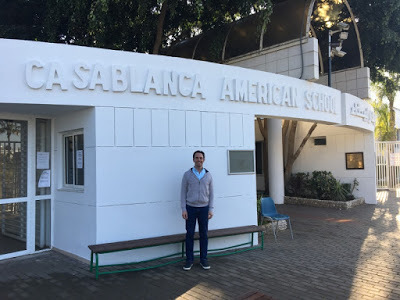
The majority of the student population is Moroccan. They are an exuberant bunch. Lots of hugs from elementary kids—and some local staff. Even the warm-hearted man who drove me from the airport to the hotel, the hotel to the train station, etc., but who spoke little English, embraced me at one point. I think Moroccans pride themselves on being welcoming, though I feel the people of most countries I've visited were similar (if not as huggy).
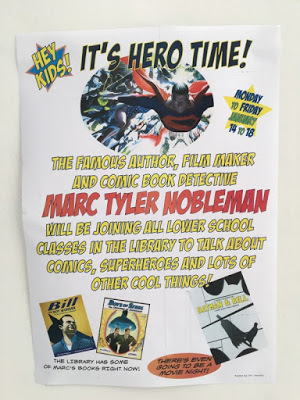
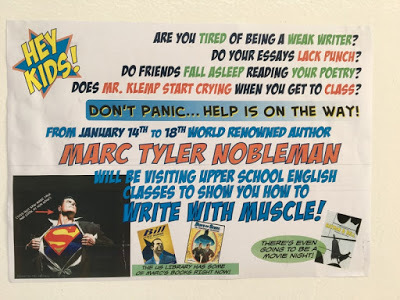
About a month before I arrived in Morocco, the king decided to do away with Daylight Savings Time—and announced it only a day or so before it was set to start. When I was picked up each morning at 7:15 am, it was dark. In fact, when I started my first session of each day at 8 am, it was still dark.
One student who was especially taken by my presentations was a middle schooler whose family had moved to Morocco from China a year earlier; he took the name Mike. He came with no English. Not only did Mike now speak English fairly well, he was not remotely shy. During his writing workshop, he took notes in both English and Chinese, asked questions, and came up to me after to ask for a signature; he also said he wanted to have a conversation with me the next day.
The school screened Batman & Bill on Wednesday afternoon for grades 4-8 and their families. Mike came with his parents, who spoke little English. His mom had made me a modest yet lovely banner. I'm told it says "Batman (Bianfu Xia) and Bill (Bi er)" in modern Chinese script (simplified characters). The vertical column on the left is the artist's name and the date, followed by her chop in red.
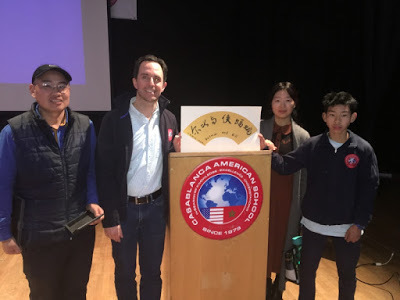
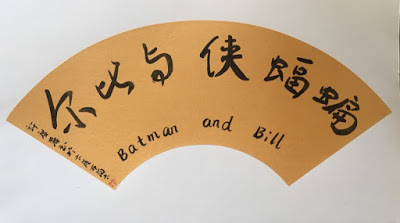
The library collection includes a few rare first editions.

Heidi has a team of student volunteers, each of whom curate a shelf each week and can win an award for it.
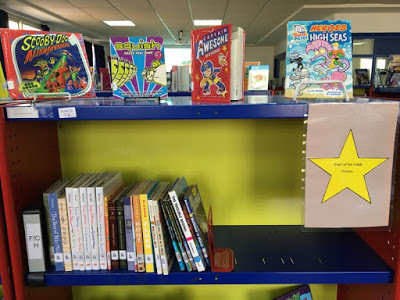
Though many schools would like to post a sign like this (aimed at the parents), this is the only one I've seen that has followed through.
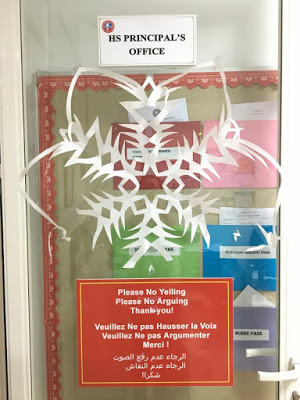
Another sign you typically don't see in schools without a significant Muslim population:
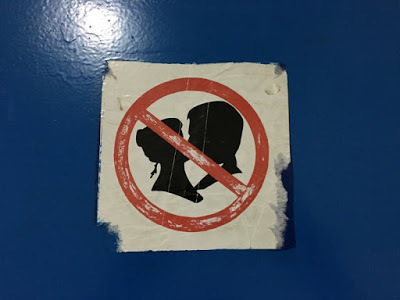
(I saw a similar sign in Malaysia.)
More than 20 years ago, the school would host an authors' festival and bring in four at a time. At one point, they hosted Norman Bridwell, creator of Clifford the Big Red Dog. He left sketches behind.
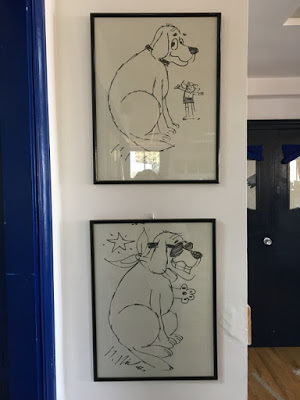
The lower school had a "design your classroom door" contest and despite my lack of training in that regard, I was honored to be named one of the judges. Two groups won first place (one for each floor of the lower school) and both reacted so cutely. Upon hearing her class won, one kindergartner shouted "I'm telling my mom!"
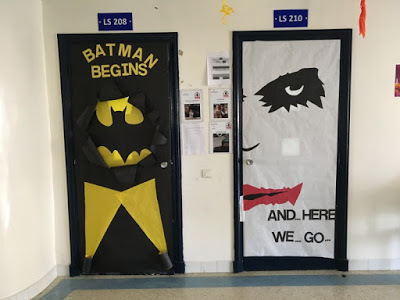 Not one of the winners, but cool.
Not one of the winners, but cool.
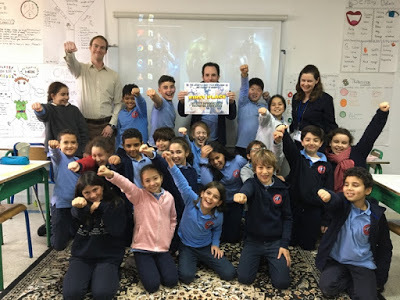
Another piece of art I was gifted (from a gifted fourth grader):
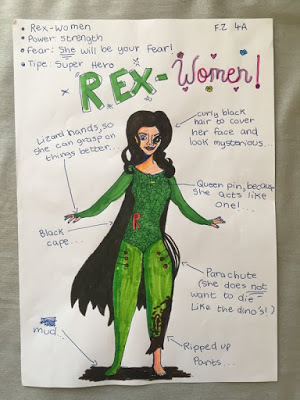
Heidi and her supremely kind assistant, Bouchra:
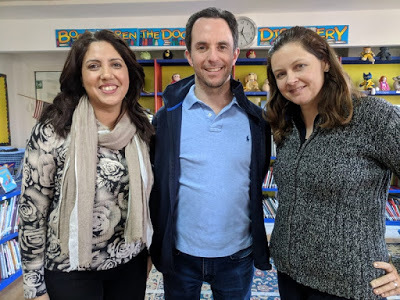
Heidi and her fun family:
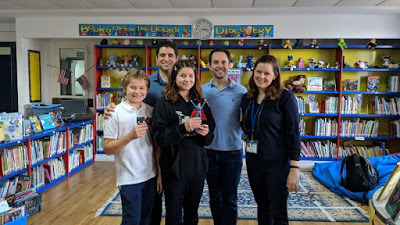
Our daughters are the same age and already connected on Instagram.
Thank you, Heidi, for being so thorough, so accommodating, so protective. As is said in the movie named for your current city, this looks like the beginning of a beautiful friendship.

The majority of the student population is Moroccan. They are an exuberant bunch. Lots of hugs from elementary kids—and some local staff. Even the warm-hearted man who drove me from the airport to the hotel, the hotel to the train station, etc., but who spoke little English, embraced me at one point. I think Moroccans pride themselves on being welcoming, though I feel the people of most countries I've visited were similar (if not as huggy).


About a month before I arrived in Morocco, the king decided to do away with Daylight Savings Time—and announced it only a day or so before it was set to start. When I was picked up each morning at 7:15 am, it was dark. In fact, when I started my first session of each day at 8 am, it was still dark.
One student who was especially taken by my presentations was a middle schooler whose family had moved to Morocco from China a year earlier; he took the name Mike. He came with no English. Not only did Mike now speak English fairly well, he was not remotely shy. During his writing workshop, he took notes in both English and Chinese, asked questions, and came up to me after to ask for a signature; he also said he wanted to have a conversation with me the next day.
The school screened Batman & Bill on Wednesday afternoon for grades 4-8 and their families. Mike came with his parents, who spoke little English. His mom had made me a modest yet lovely banner. I'm told it says "Batman (Bianfu Xia) and Bill (Bi er)" in modern Chinese script (simplified characters). The vertical column on the left is the artist's name and the date, followed by her chop in red.


The library collection includes a few rare first editions.

Heidi has a team of student volunteers, each of whom curate a shelf each week and can win an award for it.

Though many schools would like to post a sign like this (aimed at the parents), this is the only one I've seen that has followed through.

Another sign you typically don't see in schools without a significant Muslim population:

(I saw a similar sign in Malaysia.)
More than 20 years ago, the school would host an authors' festival and bring in four at a time. At one point, they hosted Norman Bridwell, creator of Clifford the Big Red Dog. He left sketches behind.

The lower school had a "design your classroom door" contest and despite my lack of training in that regard, I was honored to be named one of the judges. Two groups won first place (one for each floor of the lower school) and both reacted so cutely. Upon hearing her class won, one kindergartner shouted "I'm telling my mom!"
 Not one of the winners, but cool.
Not one of the winners, but cool.
Another piece of art I was gifted (from a gifted fourth grader):

Heidi and her supremely kind assistant, Bouchra:

Heidi and her fun family:

Our daughters are the same age and already connected on Instagram.
Thank you, Heidi, for being so thorough, so accommodating, so protective. As is said in the movie named for your current city, this looks like the beginning of a beautiful friendship.
Published on January 22, 2019 04:00
Casablanca American School
The librarian who brought me to the United Nations International School in Hanoi, Vietnam in 2016, Julie Conroy, kindly referred me to the new librarian of this school, Heidi Hendry. (Heidi's family had been at UNIS when I was there, and I met her husband and kids, but apparently not her.)

The majority of the student population is Moroccan. They are an exuberant bunch. Lots of hugs from elementary kids—and some local staff. Even the warm-hearted man who drove me from the airport to the hotel, the hotel to the train station, etc., but who spoke little English, embraced me at one point. I think Moroccans pride themselves on being welcoming, though I feel the people of most countries I've visited were similar (if not as huggy).


About a month before I arrived in Morocco, the king decided to do away with Daylight Savings Time—and announced it only a day or so before it was set to start. When I was picked up each morning at 7:15 am, it was dark. In fact, when I started my first session of each day at 8 am, it was still dark.
One student who was especially taken by my presentations was a middle schooler whose family had moved to Morocco from China a year earlier; he took the name Mike. He came with no English. Not only did Mike now speak English fairly well, he was not remotely shy. During his writing workshop, he took notes in both English and Chinese, asked questions, and came up to me after to ask for a signature; he also said he wanted to have a conversation with me the next day.
The school screened Batman & Bill on Wednesday afternoon for grades 4-8 and their families. Mike came with his parents, who spoke little English. His mom had made me a modest yet lovely banner. I'm told it says "Batman (Bianfu Xia) and Bill (Bi er)" in modern Chinese script (simplified characters). The vertical column on the left is the artist's name and the date, followed by her chop in red.


The library collection includes a few rare first editions.

Heidi has a team of student volunteers, each of whom curate a shelf each week and can win an award for it.

Though many schools would like to post a sign like this (aimed at the parents), this is the only one I've seen that has followed through.

Another sign you typically don't see in schools without a significant Muslim population:

(I saw a similar sign in Malaysia.)
More than 20 years ago, the school would host an authors' festival and bring in four at a time. At one point, they hosted Norman Bridwell, creator of Clifford the Big Red Dog. He left sketches behind.

The lower school had a "design your classroom door" contest and despite my lack of training in that regard, I was honored to be named one of the judges. Two groups won first place (one for each floor of the lower school) and both reacted so cutely. Upon hearing her class won, one kindergartner shouted "I'm telling my mom!"
 Not one of the winners, but cool.
Not one of the winners, but cool.

Another piece of art I was gifted (from a gifted fourth grader):

Heidi and her supremely kind assistant, Bouchra:

Heidi and her fun family:

Our daughters are the same age and already connected on Instagram.
Thank you, Heidi, for being so thorough, so accommodating, so protective. As is said in the movie named for your current city, this looks like the beginning of a beautiful friendship.

The majority of the student population is Moroccan. They are an exuberant bunch. Lots of hugs from elementary kids—and some local staff. Even the warm-hearted man who drove me from the airport to the hotel, the hotel to the train station, etc., but who spoke little English, embraced me at one point. I think Moroccans pride themselves on being welcoming, though I feel the people of most countries I've visited were similar (if not as huggy).


About a month before I arrived in Morocco, the king decided to do away with Daylight Savings Time—and announced it only a day or so before it was set to start. When I was picked up each morning at 7:15 am, it was dark. In fact, when I started my first session of each day at 8 am, it was still dark.
One student who was especially taken by my presentations was a middle schooler whose family had moved to Morocco from China a year earlier; he took the name Mike. He came with no English. Not only did Mike now speak English fairly well, he was not remotely shy. During his writing workshop, he took notes in both English and Chinese, asked questions, and came up to me after to ask for a signature; he also said he wanted to have a conversation with me the next day.
The school screened Batman & Bill on Wednesday afternoon for grades 4-8 and their families. Mike came with his parents, who spoke little English. His mom had made me a modest yet lovely banner. I'm told it says "Batman (Bianfu Xia) and Bill (Bi er)" in modern Chinese script (simplified characters). The vertical column on the left is the artist's name and the date, followed by her chop in red.


The library collection includes a few rare first editions.

Heidi has a team of student volunteers, each of whom curate a shelf each week and can win an award for it.

Though many schools would like to post a sign like this (aimed at the parents), this is the only one I've seen that has followed through.

Another sign you typically don't see in schools without a significant Muslim population:

(I saw a similar sign in Malaysia.)
More than 20 years ago, the school would host an authors' festival and bring in four at a time. At one point, they hosted Norman Bridwell, creator of Clifford the Big Red Dog. He left sketches behind.

The lower school had a "design your classroom door" contest and despite my lack of training in that regard, I was honored to be named one of the judges. Two groups won first place (one for each floor of the lower school) and both reacted so cutely. Upon hearing her class won, one kindergartner shouted "I'm telling my mom!"
 Not one of the winners, but cool.
Not one of the winners, but cool.
Another piece of art I was gifted (from a gifted fourth grader):

Heidi and her supremely kind assistant, Bouchra:

Heidi and her fun family:

Our daughters are the same age and already connected on Instagram.
Thank you, Heidi, for being so thorough, so accommodating, so protective. As is said in the movie named for your current city, this looks like the beginning of a beautiful friendship.
Published on January 22, 2019 04:00
January 21, 2019
Marc in Morocco
My first name is spelled the French way (though my parents aren't French or Francophiles).
I took French for five years. I got to the point where, during my junior year of college, I was able to have a conversation entirely in French for an entire dinner.
Yet that was 25 years ago and I didn't use it after that, so now most of my French has been perdu. (Tant pis because I am working on a book about a Frenchman and most of the research is in French…)
And now I am in Morocco, where French would have again come in handy. I arrived on 1/12/19 to speak and run workshops at two international schools: Casablanca International 1/14-18 and George Washington Academy 1/21-22 (also in Casablanca). The weekend between, I visited the historic Technicolor city of Marrakesh.
(Everyone at the schools speaks English, but many locals speak French or Arabic.)
As often happens when I'm in an airport, something went wrong, albeit minorly so. Upon arriving in Casablanca, I thought I was using the airport exit that led to the pickup zone, but I was actually exiting directly into the train station. But I could not simply turn around and return to the airport. I had to go back through security—the kind that didn't care if your bag falls off the belt. (Ask me how I know.)
Smoking is still allowed in restaurants here—or rather, it's not, but most don't enforce it. A chatty proprietor of a mall food court sandwich place told me their other location in town—a standalone restaurant—is better because you can smoke there. Smoking is also still allowed in other public spaces like hotel lobbies. By the way, I loathe smoking.
I've had the privilege of being invited to a good number of international schools, and they have in common the commitment to hospitality. They often put authors up in four- or five-star hotels. The first of the two Casablanca hotels I stayed at, Kenzi Tower, had an elevator system I've not seen before. You don't simply summon the elevator with an up or down button; rather you punch in your floor number and a small screen indicates which of the four elevators to take. Once in the elevator, you push nothing. It already knows.
The Kenzi breakfast was abundance and the tables were nicely set, except for one odd omission: no napkins either on the tables or anywhere along the buffet. You had to ask for one.
While Kenzi was in the city, the second hotel, Club Val D'Anfa, was at the beach. The view from my first floor room:
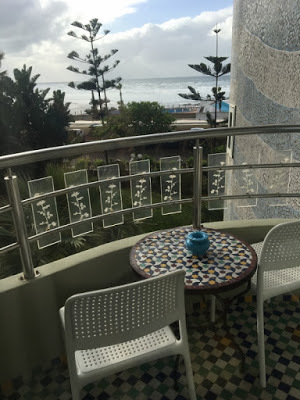
The nearly empty pool you pass to get to the shore:
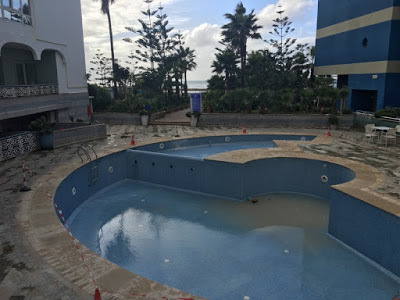
Then:
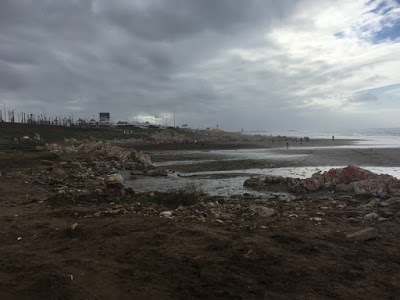
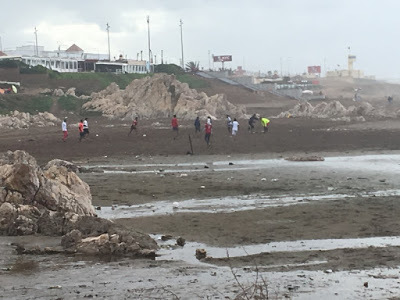
This boy of about eight asked me if I wanted to ride his horse for 6 dirhams (about 60 cents).
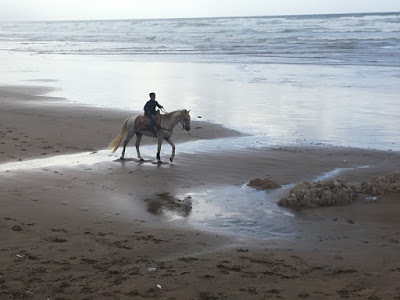
The view behind the beach:
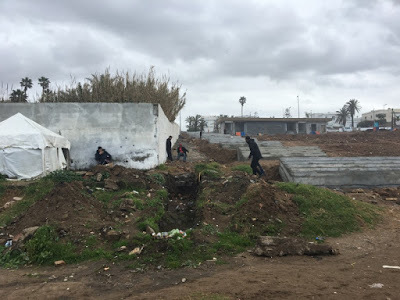
Further behind, the building appointed in blue toward the back left of the photo is my hotel.
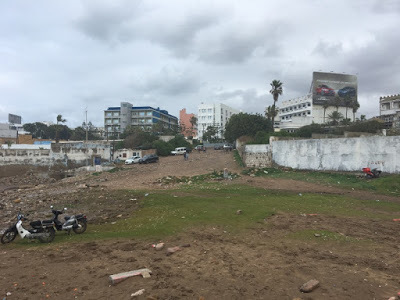
Morocco has a range of biomes. In Casablanca in January, nights are cold. I was not prepared for how chilly the days (at least the mornings are). One person told me it's colder here now than it's been in memory. No matter. I like the cold as much as I dislike smoking.
I haven't felt that Moroccan men are taller than Americans, so I don't know why the urinals are higher. I'm 5'8" and anyone even a few inches shorter than me would be, well, challenged.
The day after I arrived (which was the day before I started at the school), a group of teachers gave up their free time to take me around the city. We started at the Hassan II Mosque, which sits spectacularly on a promontory on the Atlantic Ocean. It introduced me to a concept that should not have surprised me but which I'd never considered: a new mosque. Construction began in 1987 and lasted six years. What makes that all the more remarkable is how big it is: it has room for 25,000 worshipers inside. Its minaret is 210 meters (690 feet) which is, depending on the source, the third- or fifth-largest in the world.
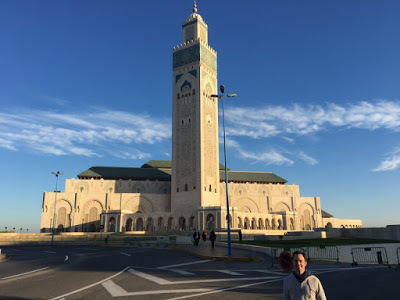
A rainbow of olives at a market:
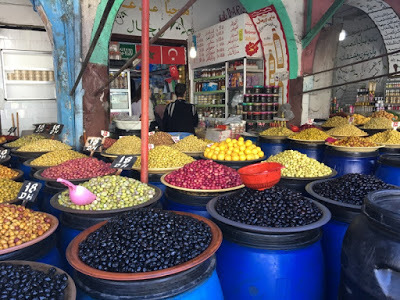
A charming bakery downstairs from street level; my attention was called to more than a couple bakeries that are not clearly marked from the outside:
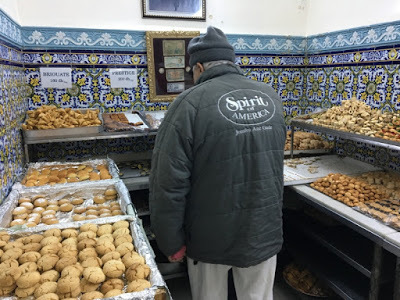
I don't get the sense that this is a prime tourist attraction, but I was amused by the outdoor café chair bedecked in imagery from Michael Jackson's "Bad" era:
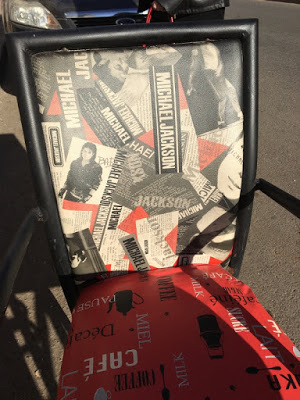
(He's going through another bad era now with abuse allegations resurfacing, which, if true, is unspeakably distressing and tragic.)
Speaking of music, for some reason, most of the songs I heard on taxi radios and in restaurants were English-language covers of American pop hits—Whitney Houston, Britney Spears, Bryan Adams, Foreigner, and so on.
To many an American, Casablanca is best known for Casablanca, the 1942 Hollywood movie starring Humphrey Bogart and Ingrid Bergman that won Best Picture and routinely tops "best movies of all time" lists. The movie was not filmed in Casablanca and Rick's Café did not exist before the movie—or for decades after. But an enterprising businessperson finally brought it to its namesake city.
I felt like an uncultured tourist when I asked to see it, since it's not authentic, but it's also not exactly a tourist trap. Sure, it caters to Americans and other visitors, but the food is actually good and the atmosphere is authentic.
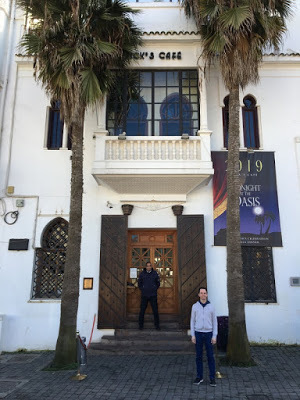
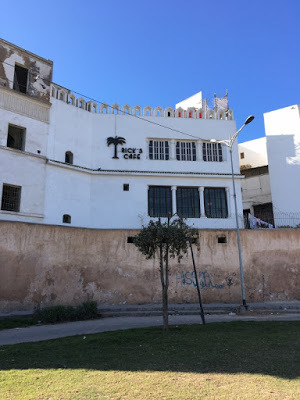 View from the rear.
View from the rear.
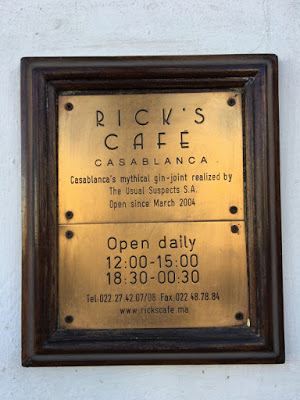
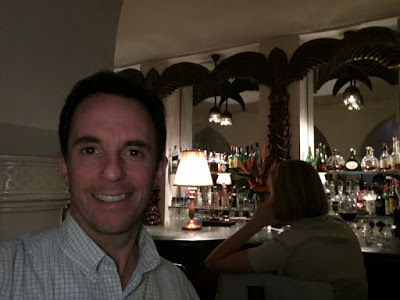
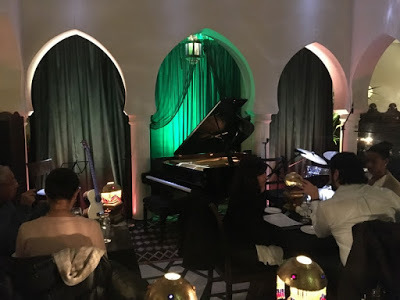
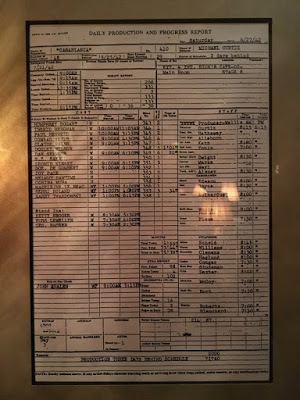
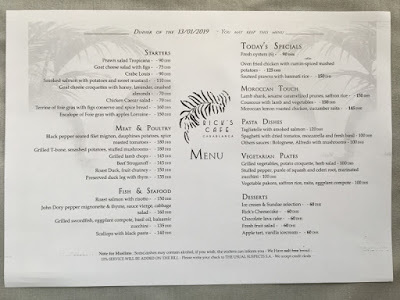
It wasn't on the menu at Rick's, but one can eat camel in Morocco.
I, however, didn't.
Vive la Morocco!
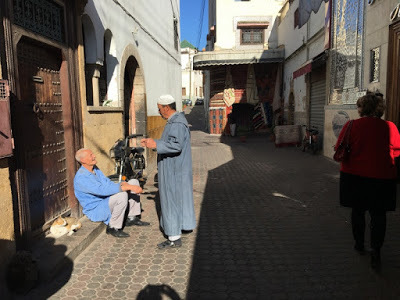
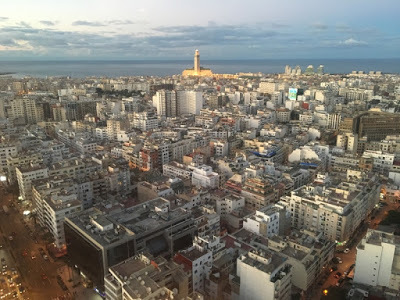
I took French for five years. I got to the point where, during my junior year of college, I was able to have a conversation entirely in French for an entire dinner.
Yet that was 25 years ago and I didn't use it after that, so now most of my French has been perdu. (Tant pis because I am working on a book about a Frenchman and most of the research is in French…)
And now I am in Morocco, where French would have again come in handy. I arrived on 1/12/19 to speak and run workshops at two international schools: Casablanca International 1/14-18 and George Washington Academy 1/21-22 (also in Casablanca). The weekend between, I visited the historic Technicolor city of Marrakesh.
(Everyone at the schools speaks English, but many locals speak French or Arabic.)
As often happens when I'm in an airport, something went wrong, albeit minorly so. Upon arriving in Casablanca, I thought I was using the airport exit that led to the pickup zone, but I was actually exiting directly into the train station. But I could not simply turn around and return to the airport. I had to go back through security—the kind that didn't care if your bag falls off the belt. (Ask me how I know.)
Smoking is still allowed in restaurants here—or rather, it's not, but most don't enforce it. A chatty proprietor of a mall food court sandwich place told me their other location in town—a standalone restaurant—is better because you can smoke there. Smoking is also still allowed in other public spaces like hotel lobbies. By the way, I loathe smoking.
I've had the privilege of being invited to a good number of international schools, and they have in common the commitment to hospitality. They often put authors up in four- or five-star hotels. The first of the two Casablanca hotels I stayed at, Kenzi Tower, had an elevator system I've not seen before. You don't simply summon the elevator with an up or down button; rather you punch in your floor number and a small screen indicates which of the four elevators to take. Once in the elevator, you push nothing. It already knows.
The Kenzi breakfast was abundance and the tables were nicely set, except for one odd omission: no napkins either on the tables or anywhere along the buffet. You had to ask for one.
While Kenzi was in the city, the second hotel, Club Val D'Anfa, was at the beach. The view from my first floor room:

The nearly empty pool you pass to get to the shore:

Then:


This boy of about eight asked me if I wanted to ride his horse for 6 dirhams (about 60 cents).

The view behind the beach:

Further behind, the building appointed in blue toward the back left of the photo is my hotel.

Morocco has a range of biomes. In Casablanca in January, nights are cold. I was not prepared for how chilly the days (at least the mornings are). One person told me it's colder here now than it's been in memory. No matter. I like the cold as much as I dislike smoking.
I haven't felt that Moroccan men are taller than Americans, so I don't know why the urinals are higher. I'm 5'8" and anyone even a few inches shorter than me would be, well, challenged.
The day after I arrived (which was the day before I started at the school), a group of teachers gave up their free time to take me around the city. We started at the Hassan II Mosque, which sits spectacularly on a promontory on the Atlantic Ocean. It introduced me to a concept that should not have surprised me but which I'd never considered: a new mosque. Construction began in 1987 and lasted six years. What makes that all the more remarkable is how big it is: it has room for 25,000 worshipers inside. Its minaret is 210 meters (690 feet) which is, depending on the source, the third- or fifth-largest in the world.

A rainbow of olives at a market:

A charming bakery downstairs from street level; my attention was called to more than a couple bakeries that are not clearly marked from the outside:

I don't get the sense that this is a prime tourist attraction, but I was amused by the outdoor café chair bedecked in imagery from Michael Jackson's "Bad" era:

(He's going through another bad era now with abuse allegations resurfacing, which, if true, is unspeakably distressing and tragic.)
Speaking of music, for some reason, most of the songs I heard on taxi radios and in restaurants were English-language covers of American pop hits—Whitney Houston, Britney Spears, Bryan Adams, Foreigner, and so on.
To many an American, Casablanca is best known for Casablanca, the 1942 Hollywood movie starring Humphrey Bogart and Ingrid Bergman that won Best Picture and routinely tops "best movies of all time" lists. The movie was not filmed in Casablanca and Rick's Café did not exist before the movie—or for decades after. But an enterprising businessperson finally brought it to its namesake city.
I felt like an uncultured tourist when I asked to see it, since it's not authentic, but it's also not exactly a tourist trap. Sure, it caters to Americans and other visitors, but the food is actually good and the atmosphere is authentic.

 View from the rear.
View from the rear.




It wasn't on the menu at Rick's, but one can eat camel in Morocco.
I, however, didn't.
Vive la Morocco!


Published on January 21, 2019 04:00
January 19, 2019
"Thirty Minutes Over Oregon" curriculum guide
Once upon a while ago, I would put together curriculum guides for my books.
Life (surely for all of us) has gotten busier since then, so I haven't yet stolen the time to create a curriculum guide for my last few releases…but luckily for me, with respect to my latest, Thirty Minutes Over Oregon, someone else did. Luckily for you, it's far richer than what I would've produced.
Thirty Minutes Over Oregon curriculum guide
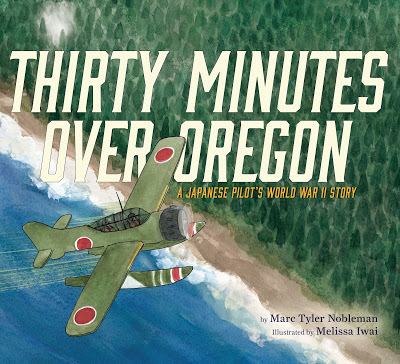
Thank you again, Mary Ann Cappiello!
Life (surely for all of us) has gotten busier since then, so I haven't yet stolen the time to create a curriculum guide for my last few releases…but luckily for me, with respect to my latest, Thirty Minutes Over Oregon, someone else did. Luckily for you, it's far richer than what I would've produced.
Thirty Minutes Over Oregon curriculum guide

Thank you again, Mary Ann Cappiello!
Published on January 19, 2019 04:00
January 11, 2019
Featured Speaker at 2019 Texas Library Association Conference
Among authors of books for young readers, the Texas Library Association Conference holds an almost mythic status. Some say it's the second best library conference (after the American Library Association's) and some say it's the most fun of all literary conferences.
I'm about to find out firsthand.
In April, I'll be participating in my first TLA, and as a Featured Speaker. I am always grateful and humbled to be asked to speak but did not realize the extent of this honor till I saw the conference program. Though the conference is huge, there are only two pages of Featured Speakers; I would have guessed many more.
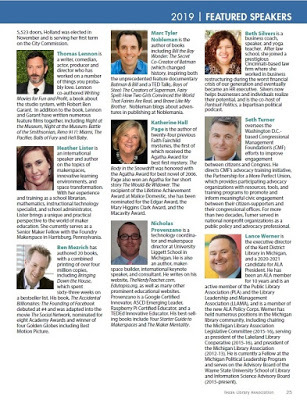
In any case, I look forward, Texas-style (i.e. in a big way)!
I'm about to find out firsthand.
In April, I'll be participating in my first TLA, and as a Featured Speaker. I am always grateful and humbled to be asked to speak but did not realize the extent of this honor till I saw the conference program. Though the conference is huge, there are only two pages of Featured Speakers; I would have guessed many more.

In any case, I look forward, Texas-style (i.e. in a big way)!
Published on January 11, 2019 04:00
December 31, 2018
Most humbling "Batman & Bill" tweets/posts of 2018
The documentary Batman & Bill came out in May 2017; the love for it (i.e. for Bill Finger) continued throughout 2018. Not one but two tweets compared it to the NBC sobfest This Is Us (yes, This Is Odd!)...
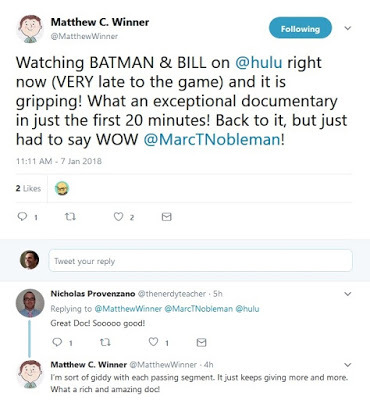
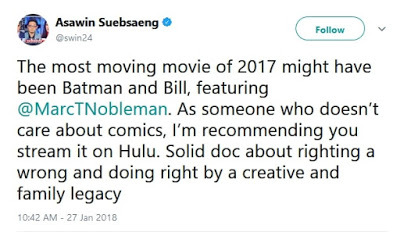
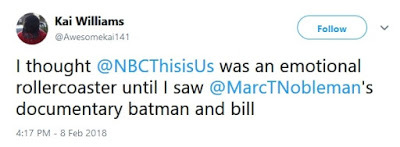

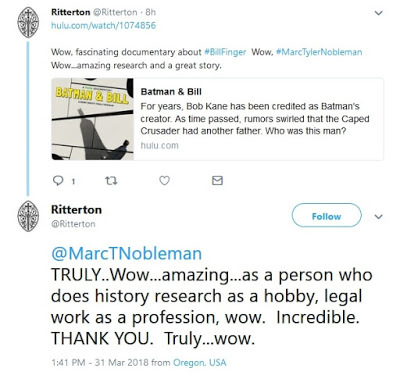
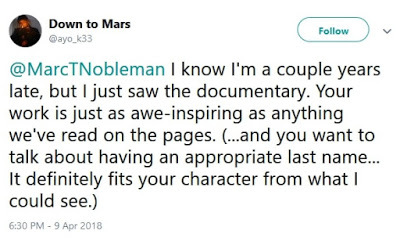
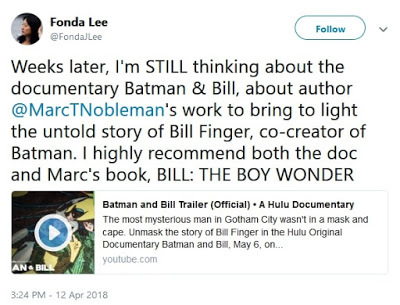

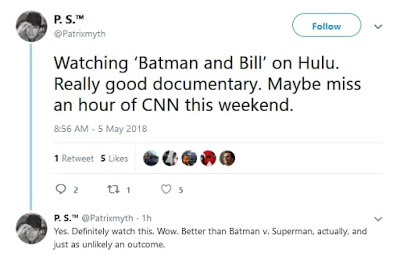

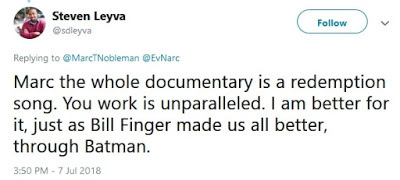
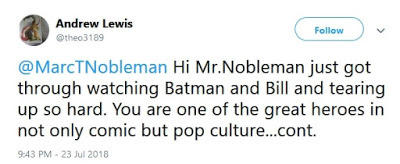
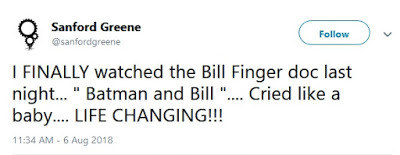
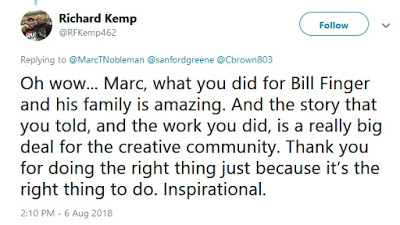
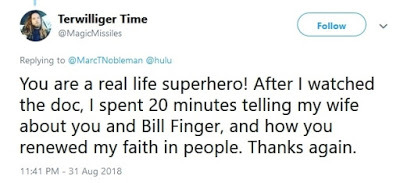
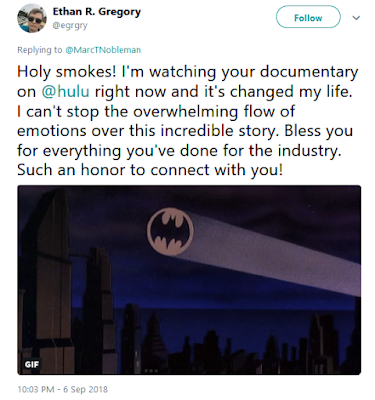
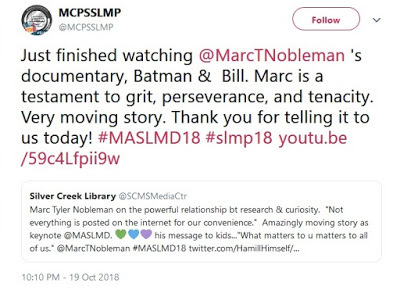


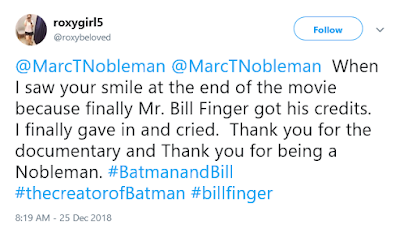
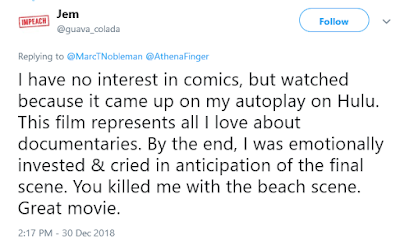
Thank you all. And to all a Dark Knight.





















Thank you all. And to all a Dark Knight.
Published on December 31, 2018 04:00
December 29, 2018
"Thirty Minutes Over Oregon" on Nerdy Book Club list of best nonfiction picture books of 2018

Thirty Minutes Over Oregon: A Japanese Pilot's World War II Story is one of the 18 titles elected to the Nerdy Book Club's list of the best nonfiction picture books of 2018.
Congrats to the other 17!
Thank you all!
Published on December 29, 2018 04:00
December 28, 2018
"Thirty Minutes Over Oregon" on Fuse #8 list of favorite nonfiction picture books of 2018
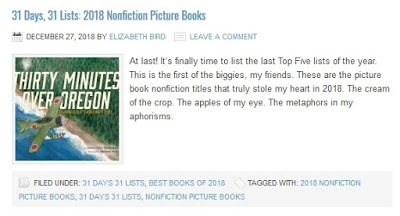
"One of the most interesting titles of the year …
beautifully illustrated, and beautifully told"

Congrats to the other kidlit creators who made any of these 31 lists!
Thank you, Betsy!
Published on December 28, 2018 04:00
December 27, 2018
Visiting Beatles sites in Hamburg, Germany
My wife was raised in Hamburg, Germany and so, in a way, were the Beatles. Between 1960 and 1962, the band came there for five engagements, some spanning months. Hamburg was the first place they played outside of the UK, and it was there where they began their climb to international fame.
I've been a Beatles fan since high school and I've come to Hamburg at least olnce most years since 1998, but it was not until this year when I cobbled together a tour of the Beatles sites of Hamburg (similar to what I did with another '60s watershed, the Vietnam War, in Ho Chi Minh City). As far as I know, and oddly, no guided tour exists; if it did, it would be a walking tour, and it would be short but fascinating.
My self-created tour under the misty, overcast sky of 12/26/18 consisted of six sites: four clubs, one plaza, and one residence (or, as the Beatles might say, "residence"). Of course there is so much written elsewhere on this topic so I won't dive deep on each site but rather let the images do most of the conjuring. I'm listing them in the order I came upon them, not in the order the Beatles played at them. (The stops are along what is essentially a Z-shaped path, starting at the bottom right of the letter.)
For the 1960 and 1961 shows, the lineup was John Lennon, Paul McCartney, George Harrison, Stuart Sutcliffe, and Pete Best (the latter two of whom are regular candidates for "the Fifth Beatle"). Stucliffe left the band to study painting in July 1961 (and died from a brain hemorrhage the following April). Ringo Starr replaced Best in August 1962.
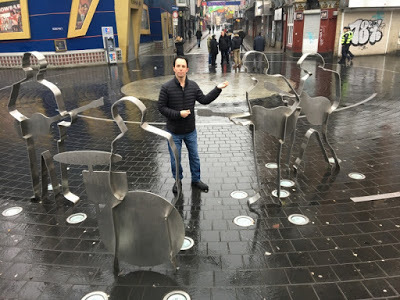 The Fifth Beatle no one talks about.
The Fifth Beatle no one talks about.
The tour:
Top Ten Club; Hamburg gig #3
136 Reeperbahn
The Beatles played there April 1-July 1, 1961 and roomed upstairs. The club had opened the year before and closed in 1994. (The entrance was between the green walls to the right of the Pizza Hut.)
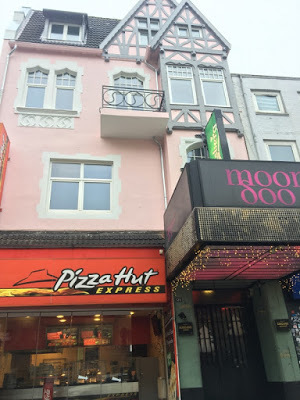
Beatles-Platz (Beatles Plaza)
corner of Reeperbahn/Grosse Freiheit
This installation was created and dedicated in 2008. It depicts the metallic outlines of five Beatles. One is apparently a composite of Best and Starr and the one set apart represents Sutcliffe because he had quit. They are standing on what is meant to resemble a vinyl record. Names of Beatles songs follow one after 909 within the silver rings on the ground.
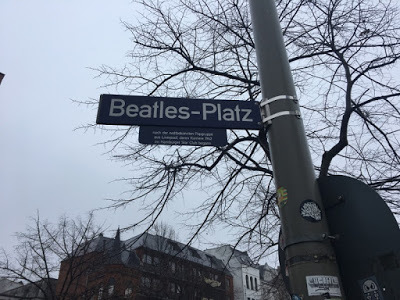
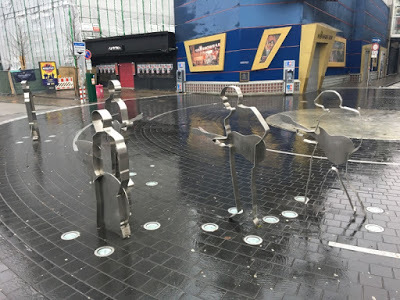
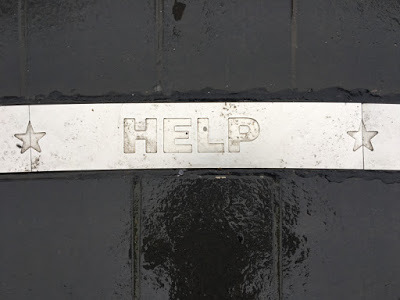
Kaiserkeller; Hamburg gig #2
38 Grosse Freiheit
The Beatles played there July 31 and October 4-November 30, 1960; it had opened in 1959. It's on a (big) side street off the main drag (the Reeperbahn), about a five-minute walk around the corner from the former Top Ten. Many other notables from Duran Duran to Prince to Hamburg's own Nena have since performed there. It's still going.
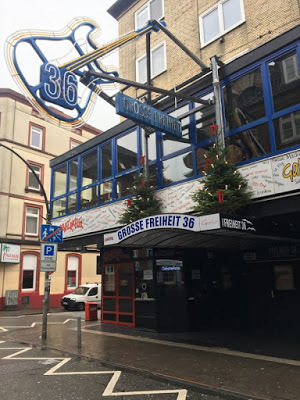
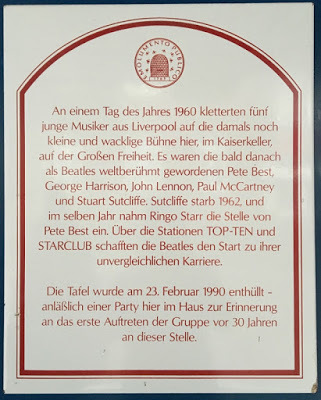
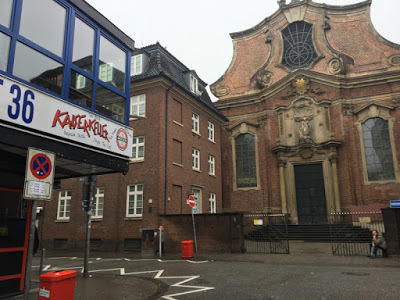 Yes, there is a church across the street(not only spitting distance from the rock and rollrowdiness but also mere steps away from strip clubs).
Yes, there is a church across the street(not only spitting distance from the rock and rollrowdiness but also mere steps away from strip clubs).
Star-Club; Hamburg gig #4
39 Grosse Freiheit
Star-Club stood across the street from Kaiserkeller. The Beatles played there April 13-May 31, November 1-14, and December 18-31, 1962. Shortly after the group arrived for their first Star-Club appearance (which was also the club's opening night), they learned that their former bandmate Sutcliffe had passed away.
At that time, with its 2,000-seat capacity, this was the area's largest club. The November and December dates were the first in Hamburg with Ringo Starr. The Beatles were not keen to play those dates because their first single, "Love Me Do," was already charting in the UK, but did so to fulfill their contract. December 31 would mark the group's final pre-Beatlemania show in Hamburg. This is the only venue on this list whose original structure is no longer there; it ceased being a club in 1969 and burned down in 1987. The commemorative marker is in a side commercial courtyard accessed under an archway.
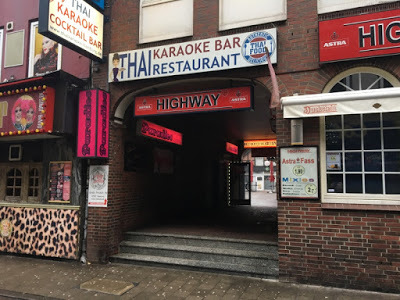
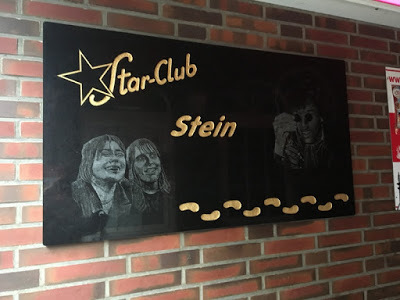
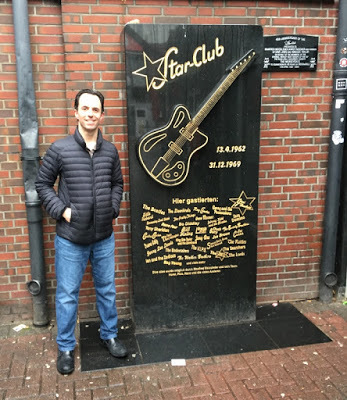
Indra Club; Hamburg gig #164 Grosse Freiheit
The Beatles' Hamburg debut took place here; the gig ran August 17-October 3, 1960. The Indra was a block outside the liveliest section of the street, which allegedly frustrated the band. They wanted to be at the center of the scene.
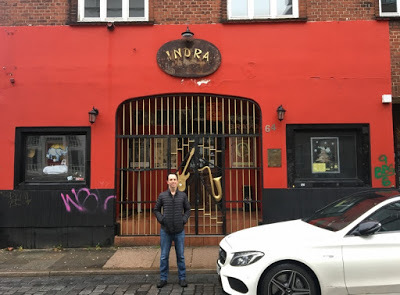
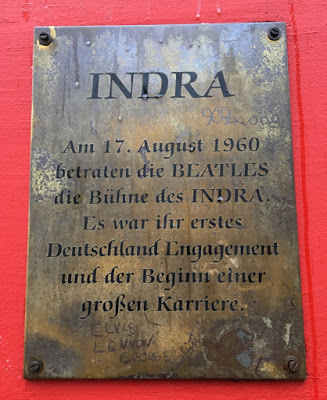
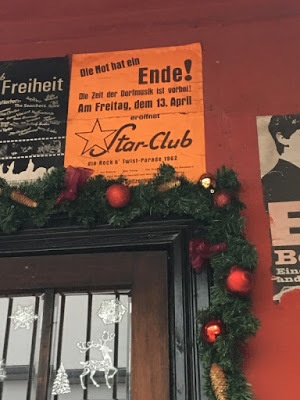 In a brotherly nod, the Indra displays a poster for the now-defunct Star-Club's opening night.
In a brotherly nod, the Indra displays a poster for the now-defunct Star-Club's opening night.
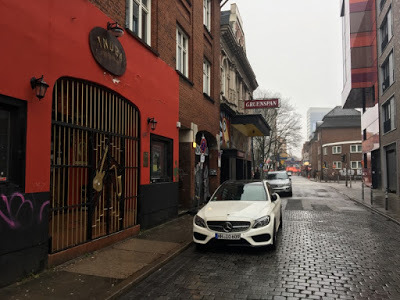 When this photo is enlarged, you can see in the near distancethe blue "36" of the sign for Kaiserkeller; the Beatles felt that due to its "outlier" locale, this club was not cool enough.
When this photo is enlarged, you can see in the near distancethe blue "36" of the sign for Kaiserkeller; the Beatles felt that due to its "outlier" locale, this club was not cool enough.
Bambi Kino
33 Paul-Roosen Strasse
The Beatles stayed here while playing at the Indra. It was the dirty, unpainted, windowless former storeroom (or perhaps two) of a small cinema, and though half of their time there was during summer, it was nonetheless cold. The cinema is gone but the cartoon deer painted on the garage door indicates where it was.
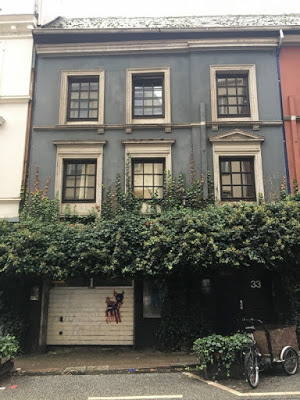
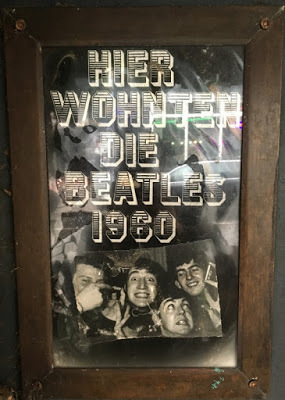
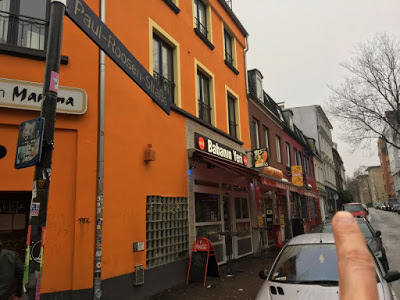 I'm pointing to Bambi Kino. Note the street sign...
I'm pointing to Bambi Kino. Note the street sign...
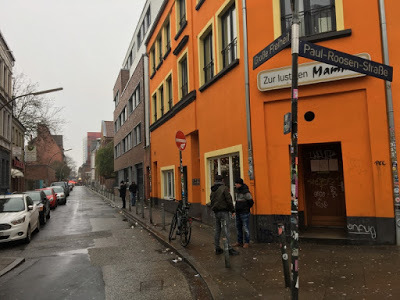 ...seen here again, where it meets the street home to the Indra.(I didn't point this time, but it's the slightly taller
...seen here again, where it meets the street home to the Indra.(I didn't point this time, but it's the slightly taller
brick building a ways down on the left.)I loved visualizing the way the Beatles would've walked to work...
I was surprised to learn that a museum called Beatlemania Hamburg opened near the club district in 2009, and more surprised to learn that it closed in 2012 due to underwhelming attendance.
"Underwhelming" is rarely a word you hear in connection with the Beatles.
No matter the museum; it was a blast to get back to where they once belonged.
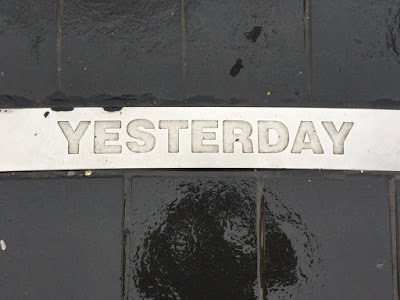
I've been a Beatles fan since high school and I've come to Hamburg at least olnce most years since 1998, but it was not until this year when I cobbled together a tour of the Beatles sites of Hamburg (similar to what I did with another '60s watershed, the Vietnam War, in Ho Chi Minh City). As far as I know, and oddly, no guided tour exists; if it did, it would be a walking tour, and it would be short but fascinating.
My self-created tour under the misty, overcast sky of 12/26/18 consisted of six sites: four clubs, one plaza, and one residence (or, as the Beatles might say, "residence"). Of course there is so much written elsewhere on this topic so I won't dive deep on each site but rather let the images do most of the conjuring. I'm listing them in the order I came upon them, not in the order the Beatles played at them. (The stops are along what is essentially a Z-shaped path, starting at the bottom right of the letter.)
For the 1960 and 1961 shows, the lineup was John Lennon, Paul McCartney, George Harrison, Stuart Sutcliffe, and Pete Best (the latter two of whom are regular candidates for "the Fifth Beatle"). Stucliffe left the band to study painting in July 1961 (and died from a brain hemorrhage the following April). Ringo Starr replaced Best in August 1962.
 The Fifth Beatle no one talks about.
The Fifth Beatle no one talks about.The tour:
Top Ten Club; Hamburg gig #3
136 Reeperbahn
The Beatles played there April 1-July 1, 1961 and roomed upstairs. The club had opened the year before and closed in 1994. (The entrance was between the green walls to the right of the Pizza Hut.)

Beatles-Platz (Beatles Plaza)
corner of Reeperbahn/Grosse Freiheit
This installation was created and dedicated in 2008. It depicts the metallic outlines of five Beatles. One is apparently a composite of Best and Starr and the one set apart represents Sutcliffe because he had quit. They are standing on what is meant to resemble a vinyl record. Names of Beatles songs follow one after 909 within the silver rings on the ground.



Kaiserkeller; Hamburg gig #2
38 Grosse Freiheit
The Beatles played there July 31 and October 4-November 30, 1960; it had opened in 1959. It's on a (big) side street off the main drag (the Reeperbahn), about a five-minute walk around the corner from the former Top Ten. Many other notables from Duran Duran to Prince to Hamburg's own Nena have since performed there. It's still going.


 Yes, there is a church across the street(not only spitting distance from the rock and rollrowdiness but also mere steps away from strip clubs).
Yes, there is a church across the street(not only spitting distance from the rock and rollrowdiness but also mere steps away from strip clubs).Star-Club; Hamburg gig #4
39 Grosse Freiheit
Star-Club stood across the street from Kaiserkeller. The Beatles played there April 13-May 31, November 1-14, and December 18-31, 1962. Shortly after the group arrived for their first Star-Club appearance (which was also the club's opening night), they learned that their former bandmate Sutcliffe had passed away.
At that time, with its 2,000-seat capacity, this was the area's largest club. The November and December dates were the first in Hamburg with Ringo Starr. The Beatles were not keen to play those dates because their first single, "Love Me Do," was already charting in the UK, but did so to fulfill their contract. December 31 would mark the group's final pre-Beatlemania show in Hamburg. This is the only venue on this list whose original structure is no longer there; it ceased being a club in 1969 and burned down in 1987. The commemorative marker is in a side commercial courtyard accessed under an archway.



Indra Club; Hamburg gig #164 Grosse Freiheit
The Beatles' Hamburg debut took place here; the gig ran August 17-October 3, 1960. The Indra was a block outside the liveliest section of the street, which allegedly frustrated the band. They wanted to be at the center of the scene.


 In a brotherly nod, the Indra displays a poster for the now-defunct Star-Club's opening night.
In a brotherly nod, the Indra displays a poster for the now-defunct Star-Club's opening night. When this photo is enlarged, you can see in the near distancethe blue "36" of the sign for Kaiserkeller; the Beatles felt that due to its "outlier" locale, this club was not cool enough.
When this photo is enlarged, you can see in the near distancethe blue "36" of the sign for Kaiserkeller; the Beatles felt that due to its "outlier" locale, this club was not cool enough.Bambi Kino
33 Paul-Roosen Strasse
The Beatles stayed here while playing at the Indra. It was the dirty, unpainted, windowless former storeroom (or perhaps two) of a small cinema, and though half of their time there was during summer, it was nonetheless cold. The cinema is gone but the cartoon deer painted on the garage door indicates where it was.


 I'm pointing to Bambi Kino. Note the street sign...
I'm pointing to Bambi Kino. Note the street sign... ...seen here again, where it meets the street home to the Indra.(I didn't point this time, but it's the slightly taller
...seen here again, where it meets the street home to the Indra.(I didn't point this time, but it's the slightly taller brick building a ways down on the left.)I loved visualizing the way the Beatles would've walked to work...
I was surprised to learn that a museum called Beatlemania Hamburg opened near the club district in 2009, and more surprised to learn that it closed in 2012 due to underwhelming attendance.
"Underwhelming" is rarely a word you hear in connection with the Beatles.
No matter the museum; it was a blast to get back to where they once belonged.

Published on December 27, 2018 07:44



